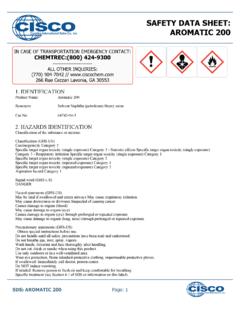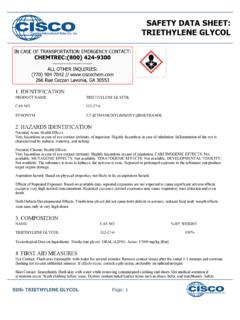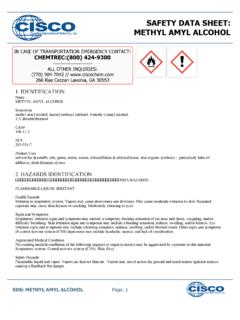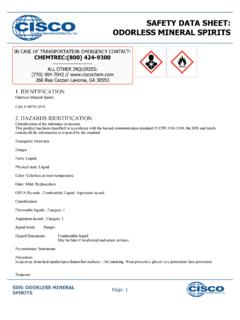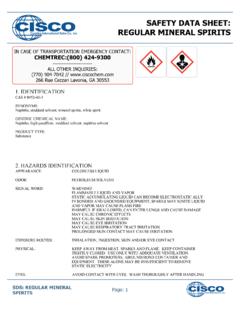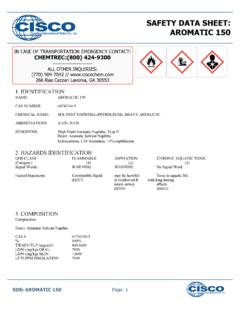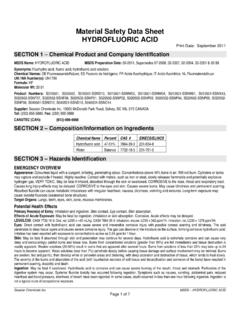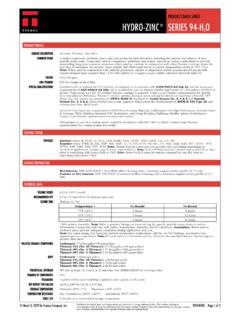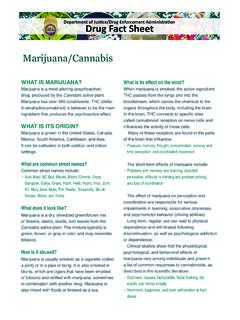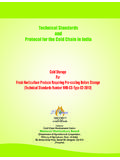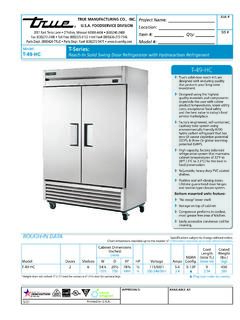Transcription of SAFETY DATA SHEET: TETRAHYDROFURAN
1 SAFETY data SHEET: TETRAHYDROFURAN1. IDENTIFICATIONPRODUCT NAME:TETRAHYDROFURANCAS #:109-99-9 SYNONYM:THF2. HAZARDS IDENTIFICATIONP otential Acute Health Effects:Hazardous in case of skin contact (irritant), of eye contact (irritant). Slightly hazardous in case of skin contact (permeator), ofingestion, of Chronic Health Effects:CARCINOGENIC EFFECTS: Not available. MUTAGENIC EFFECTS: Mutagenic for mammalian somatic cells. Mutagenic forbacteria and/or yeast. TERATOGENIC EFFECTS: Not available. DEVELOPMENTAL TOXICITY: Not available. The substancemay be toxic to blood, kidneys, lungs, liver, upper respiratory tract, skin, eyes, central nervous system (CNS). Repeated or prolongedexposure to the substance can produce target organs COMPOSITIONCOMPOSITIONNAME:CAS #% BY WEIGHTT etrahydrofuran109-99-9100%Toxicological data on Ingredients: TETRAHYDROFURAN : ORAL (LD50): Acute: 1650 mg/kg [Rat].
2 VAPOR (LC50): Acute: 21000mg/m 3 hours [Rat].4. FIRST AID MEASURESEye Contact:Check for and remove any contact lenses. In case of contact, immediately flush eyes with plenty of water for at least 15 water may be used. Get medical Contact:In case of contact, immediately flush skin with plenty of water. Cover the irritated skin with an emollient. Remove contaminatedclothing and shoes. Cold water may be used. Wash clothing before reuse. Thoroughly clean shoes before reuse. Get Skin Contact:Wash with a disinfectant soap and cover the contaminated skin with an anti-bacterial cream. Seek immediate medical CASE OF TRANSPORTATION EMERGENCY CONTACT:CHEMTREC:(800) 424-9300-----------------------ALL OTHER INQUIRIES:(770) 904-7042 // Rue Cezzan Lavonia, GA 30553 Page: 1 SDS: TETRAHYDROFURANI nhalation:If inhaled, remove to fresh air. If not breathing, give artificial respiration.
3 If breathing is difficult, give oxygen. Get Inhalation:Evacuate the victim to a safe area as soon as possible. Loosen tight clothing such as a collar, tie, belt or waistband. If breathing isdifficult, administer oxygen. If the victim is not breathing, perform mouth-to-mouth resuscitation. WARNING: It may be hazardousto the person providing aid to give mouth-to-mouth resuscitation when the inhaled material is toxic, infectious or corrosive. Seekmedical :Do NOT induce vomiting unless directed to do so by medical personnel. Never give anything by mouth to an unconscious person. Iflarge quantities of this material are swallowed, call a physician immediately. Loosen tight clothing such as a collar, tie, belt Ingestion: Not FIRE FIGHTING MEASURESF lammability of the Product: Temperature: 321 C ( F)Flash Points: CLOSED CUP: C ( F).
4 OPEN CUP: -20 C (-4 F).Flammable Limits: LOWER: 2% UPPER: of Combustion: These products are carbon oxides (CO, CO2).Fire Hazards in Presence of Various Substances:Highly flammable in presence of open flames and sparks, of heat. Non-flammable in presence of Hazards in Presence of Various Substances:Risks of explosion of the product in presence of mechanical impact: Not available. Explosive in presence of open flames and sparks,of Fighting Media and Instructions:Flammable liquid, soluble or dispersed in water. SMALL FIRE: Use DRY chemical powder. LARGE FIRE: Use alcohol foam,water spray or Remarks on Fire Hazards: Vapor may travel considerable distance to source of ignition and flash back. May form explosivemixtures with Remarks on Explosion Hazards:Reacts explosively with lithium-aluminum alloys, and Sodium Aluminum Hydride, Potassium hydroxide, Calcium is normally stable, however, prolonged storage, and exposure to air and light may cause formation of unstable explosive peroxidesespecially when anhydrous and unless it is inhibited against peroxide formation.
5 Explosive in the form of vapor when exposed toheat or ACCIDENTAL RELEASE MEASURESS mall Spill:Dilute with water and mop up, or absorb with an inert dry material and place in an appropriate waste disposal Spill:Flammable liquid. Keep away from heat. Keep away from sources of ignition. Stop leak if without risk. Absorb with DRY earth,sand or other non-combustible material. Do not touch spilled material. Prevent entry into sewers, basements or confined areas; dikeif needed. Be careful that the product is not present at a concentration level above TLV. Check TLV on the MSDS and with : 2 SDS: TETRAHYDROFURAN7. HANDLING AND STORAGEP recautions:Keep away from heat. Keep away from sources of ignition. Ground all equipment containing material. Do not ingest. Do not breathegas/fumes/ vapor/spray. Wear suitable protective clothing. In case of insufficient ventilation, wear suitable respiratory equipment.
6 Ifingested, seek medical advice immediately and show the container or the label. Avoid contact with skin and eyes. Keep away fromincompatibles such as oxidizing :Store in a segregated and approved area. Keep container in a cool, well-ventilated area. Keep container tightly closed and sealeduntil ready for use. Avoid all possible sources of ignition (spark or flame). Prolonged exposure to air and light may form unstableexplosive peroxides unless it is inhibited against peroxide formation8. EXPOSURE CONTROLS AND PERSONAL PROECTIONE ngineering Controls:Provide exhaust ventilation or other engineering controls to keep the airborne concentrations of vapors below their respectivethreshold limit value. Ensure that eyewash stations and SAFETY showers are proximal to the work-station Protection:Splash goggles. Lab coat. Vapor respirator. Be sure to use an approved/certified respirator or equivalent.
7 Protection in Case of a Large Spill:Splash goggles. Full suit. Vapor respirator. Boots. Gloves. A self contained breathing apparatus should be used to avoid inhalation ofthe product. Suggested protective clothing might not be sufficient; consult a specialist BEFORE handling this Limits:TWA: 590 STEL: 737 (mg/m3) from ACGIH (TLV) [United States] Inhalation TWA: 200 STEL: 250 (ppm) from ACGIH (TLV)[United States] Inhalation TWA: 590 STEL: 735 (mg/m3) from NIOSH [United States] Inhalation TWA: 200 STEL: 250 (ppm)from NIOSH [United States] Inhalation TWA: 200 STEL: 250 (ppm) from OSHA (PEL) [United States] Inhalation TWA: 590 STEL: 735 (mg/m3) from OSHA (PEL) [United States] Inhalation TWA: 100 STEL: 200 (ppm) [United Kingdom (UK)] InhalationTWA: 300 STEL: 599 (mg/m3) [United Kingdom (UK)] Inhalation3 Consult local authorities for acceptable exposure PHYSICAL AND CHEMICAL PROPERTIESP hysical state and appearance: : Ethereal.
8 : Weight: g/moleColor: (1% soln/water): Not Point: 65 C (149 F) @ 760 mm HgMelting Point: C ( F)Critical Temperature: 267 C ( F)Specific Gravity: (Water = 1)Vapor Pressure: kPa (@ 20 C)Vapor Density: (Air = 1)Page: 3 SDS: TETRAHYDROFURANV olatility: 100% (v/v).Odor Threshold: 20 ppm - 50 ppmWater/Oil Dist. Coeff.: The product is more soluble in oil; log(oil/water) = (in Water): Not Properties: See solubility in water, diethyl ether, :Easily soluble in diethyl ether, acetone. Partially soluble in cold water. Solubility in water is 30%. Miscible with alcohols, ketones,esters, hydrocarbons, and ethers. Very soluble in benzene, ethanol, and STABILITY AND REACTIVITYS tability: The product is Temperature: Not of Instability: Heat, ignition sources (sparks, flames), light, air, and incompatible materialsIncompatibility with various substances: Reactive with oxidizing agents, acids, : Non-corrosive in presence of Remarks on Reactivity:Reacts violently with Bromine.
9 Addition of anhydrous chlorides (hafnium tetrachloride, titanium tetrachloride, and zirconiumtetrachloride) directly to TETRAHYDROFURAN will cause a violent exothermic reaction. Also incompatible with Calcium Hydride + heat,caustics ( ammonia, ammonium hydroxide, calcium hyroxide, potassium hydroxide, sodium hydroxide), metal halides, moisture,lithium tetrahydroaluminate, borane, 2-aminophenol + potassium dioxide, sodium tetrahydroaluminate, and exposure to air and light may form unstable peroxides especially when anhydrous and unless it is inhibited againstperoxide Remarks on Corrosivity: It will attack some forms of plastics, rubber, : Will not TOXICOLOGICAL INFORMATIONR outes of Entry: Absorbed through skin. Dermal contact. Eye to Animals:WARNING: THE LC50 VALUES HEREUNDER ARE ESTIMATED ON THE BASIS OF A 4-HOUR EXPOSURE. Acute oraltoxicity (LD50): 1650 mg/kg [Rat].
10 Acute toxicity of the vapor (LC50): 24000 mg/m3 2 hours [Mouse].Chronic Effects on Humans:MUTAGENIC EFFECTS: Mutagenic for mammalian somatic cells. Mutagenic for bacteria and/or yeast. May cause damage to thefollowing organs: blood, kidneys, lungs, liver, upper respiratory tract, skin, eyes, central nervous system (CNS).Other Toxic Effects on Humans:Hazardous in case of skin contact (irritant). Slightly hazardous in case of skin contact (permeator), of ingestion, of Remarks on Toxicity to Animals: Not Remarks on Chronic Effects on Humans:It is excreted in mother's milk. May cause cancer based on animal data . No human data found at this point. May cause adversereproductive effects (fetotoxicity) based on animal data . No human data found at this point. May affect genetic Remarks on other Toxic Effects on Humans:Page: 4 SDS: TETRAHYDROFURANA cute Potential Health Effects: Skin: Causes skin irritation.
